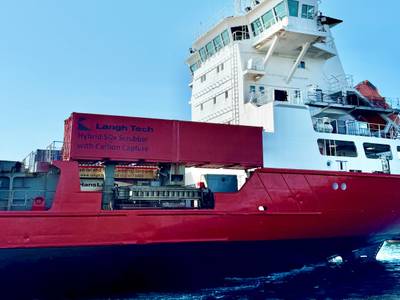Onboard Carbon Capture System Produces Marketable Product
Finnish green tech company Langh Tech has expanded its portfolio of exhaust gas treatment solutions for ships with an onboard carbon capture (OCC) system.
A unique feature of the system is the possibility to sell and utilize the sodium carbonate which results at the end of the chemical process.
A pilot test of the system on a vessel of sister company Langh Ship demonstrated capture rates of over 80% from the exhaust gas flow coming into the system. Overall CO2 emissions can be reduced by 20-30%, depending on the available space and other ship and product specifications.
The first commercial installations will take place early in 2025 onboard of four bulk carriers under construction by Damen Shipyards Group. The ships will be equipped with a hybrid scrubber and an additional onboard carbon capture system from Langh Tech.
The installations by Langh Tech are part of a project between Atal Solutions, BAM Shipping and Damen Shipyards Group. It aims at retrofitting ships with different technologies and to reduce fuel consumption to achieve a maximum reduction in CO2, SOx, and NOx emissions, while using traditional fuels.
The ultimate project goal is to bring CO2 emissions down by up to 60% with onboard carbon capture. This could be achieved through the continuous development of the system itself, as well as optimizing other limiting factors, such as installation size and onboard space, ship efficiency, loading and operations or voyage planning.
The system works by directing a ship’s exhaust gases containing CO2 into a capture unit. CO2 dissolves into the liquid phase through via a counter-currently flowing aqueous NaOH solution. A maximized surface area ensures highest possible carbon capture rates. As a result of several consecutive reactions, CO2 is chemically bound into a thermodynamically stable sodium carbonate.
In comparison to other carbon capture technologies, which are mostly based on amines, Langh Tech’s says its OCC system has noteworthy advantages:
• Sodium carbonate, the solid product, which results in the end of the OCC process, can be turned into value. It can easily be marketed as it is widely applied as a key ingredient by various other industries, for example in the manufacturing of glass and detergents.
• With Langh Tech’s post-combustion capture, there is no need for solvent regeneration or CO2 compression, which significantly reduces the additional energy consumption onboard, as well as the resources needed to operate the OCC system. No additional specialized equipment is needed. In turn, the capture reagent, sodium hydroxide, can be produced by electrolysis of sodium chloride using renewable energy. This ensures minimized emissions and sustainability over the whole lifecycle.
• Langh Tech’s OCC system allows simple operation processes which do not require new specialized equipment. The used chemical is already applied and established in the maritime industry. The sodium carbonate can be collected in containers and be easily transported.
• Langh Tech’s OCC systems are designed with flexibility in mind. They can be adapted and scaled according to the specific needs of each vessel. This approach ensures a seamless integration of the technology into the existing ship infrastructure, offering a practical solution for a wide range of ship types.













